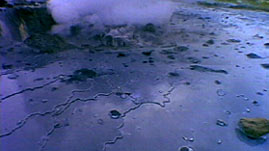It's difficult to think of free oxygen, which makes up 21 percent of earth's atmosphere, as a poisonous gas. Virtually all organisms alive today need oxygen to survive. Even plants, which expel oxygen into the atmosphere, need oxygen to live. There was a time early in earth's history, however, when living organisms not only did not need oxygen, but were killed when exposed to the element.
Three and a half billion years ago, Earth's atmosphere contained almost no free oxygen. Instead, it consisted mainly of carbon dioxide, perhaps as much as 100 times more carbon dioxide than contained in today's atmosphere. During this time, Earth's only life forms were aquatic, one-celled organisms -- primitive forms of bacteria -- that extracted energy from a variety of sources. To most of these organisms, free oxygen was poisonous.
At about the same time, new types of primitive bacteria evolved. Unlike their predecessors, these bacteria could convert energy directly from the Sun, through photosynthesis. One type, bluish-green organisms called cyanobacteria, used sunlight to convert carbon dioxide and water into glucose (sugar). These organisms expelled oxygen gas -- a by-product of photosynthesis -- into the oceans.
As the cyanobacteria multiplied and spread around the globe, they released more and more free oxygen into the oceans. This oxygen combined with the molecules of living bacteria, killing them off as it did so. It also combined with other matter, such as the iron dissolved in the ocean. Only after the oxygen combined with all of the matter available did free oxygen begin to accumulate in the oceans. And when the oceans became saturated with oxygen, it began to make its way into the atmosphere.
Organisms that don't need free oxygen to survive are called anaerobic; all living things that need free oxygen, including us, are aerobic organisms. As the oceans and atmosphere filled with oxygen gas, aerobic life evolved further, at some point adding a nucleus to the cell (to protect the cell's DNA from the harmful effects of oxygen) and eventually to multi-cellular organisms. Anaerobic life, on the other hand, was pushed back to areas where there was little or no oxygen. Today, anaerobic organisms like those that existed more than three and a half billion years ago live in oxygen-free places such as volcanic hot vents, where they get their energy in ways other than from carbon dioxide, water, and sunlight.

 Loading Standards
Loading Standards Teachers' Domain is proud to be a Pathways portal to the National Science Digital Library.
Teachers' Domain is proud to be a Pathways portal to the National Science Digital Library.
